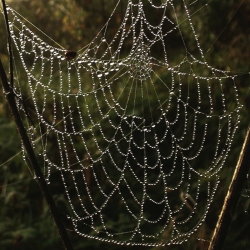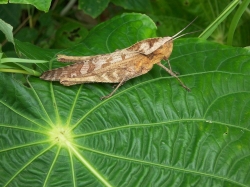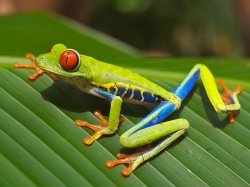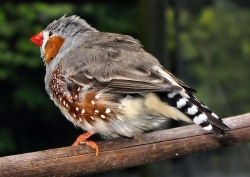What if you were a spider for a day? You would need to build a web. You would spin your silk, making spokes like a bicycle wheel. Then you would put a spiral around those spokes to connect it all. Uh-oh. A breeze just pulled apart a thread at the bottom. Go fix it or else it won't hold up! Oh great, a bird flew by and broke it apart at the top. Now the whole thing's slumping over. It's tough being a spider and keeping up your web. Now, what if you were in charge of the web of life?
You may have seen a picture of how things eat on our planet. It looks like a straight line with you at the top, plants at the bottom, and all the other animals on Earth in between. A
food chain is an easy way to show how energy starts with plants and passes from one animal to another and then to another until it gets to you. Easy, right? Well, about as easy as building a spider web. Life is a lot more complicated than a straight line.

This is going to be one hungry spider. His web is not going to fool anyone.
VladimirZhV, CC0, via Wikimedia Commons
We begin with leaves. Yummy leaves. Oh, you don't think leaves are yummy? That's okay. Lots of other living things do. Leaves are eaten by grasshoppers, caterpillars, snails, and other bugs. It does not stop there. Leaves can be eaten by many more living things, too. Grasshoppers can be eaten by birds and lizards while caterpillars are eaten by frogs and other birds. Every living thing is a part of every other living thing's food chain in one way or another. A
food web shows many different food chains together and how energy flows between all the living things in an ecosystem. If you pull back far enough, all the connections start to look like a spider web. However, it can break just as easily as that web.

This leaf is all mine.
Nat Edwards, Public domain, via Wikimedia Commons
What happens if you break a part of a spider web? Let's try it. Do not worry. This spider moved out a long time ago. We will pick a strand right in the middle here and just . . . cut it. There. Oh, look, the whole thing starts to slump. Soon, other strands will follow and the spider web will be no more. You may have noticed when you built this spider web that each side has to be pulled tight in order to hold the whole thing up. It's like a game of tug of war between two trees. If one side gives a little, the other side might topple over. It's even worse if the rope itself breaks.
Balance means that something stays where it needs to be, and doesn't go too far in one direction or another. Since there are so many parts in a food web, every part of life needs to connect and pull on every other part to keep them all balanced and alive. If the grasshoppers eat all the leaves, there will be none for the caterpillars. If the caterpillars die out so will the frogs. That will keep happening all around the web until it reaches us. I don't know about you, but I like frogs. And living.

Just hanging out looking for lunch.
Careyjamesbalboa (Carey James Balboa), Public domain, via Wikimedia Commons
Remember when you were building your web as a spider? Every single line needed all the other lines to stay up.
Resources are what a living thing needs to keep on living. They are like the lines in the spider web. There are many types of resources, including water, sun, and dirt. These all play a part in keeping the grass growing so the caterpillars can eat, the birds can eat, and you can eat.

I think I've had enough to eat today.
Arpingstone, Public domain, via Wikimedia Commons
The life of a spider isn't easy. You must keep your web safe. You have to run back and forth all the time, fixing any lines that break, or else the whole thing might come down. There are many connections in the spider's web, just as there are many connections in our food chain. If one of those connections is cut, the whole thing will start to fall apart. If we keep all of our plants and animals safe, then we, and the spiders, can keep on living.
References:
Geography 4 Kids. "Another Link
in the Food Chain." Geography 4 Kids, 2010. <
http://www.geography4kids.com/files/land_foodchain.html>
Dialogue
4 Kids. "Food Energy Facts." Idahoptv.org, 2014.
<http://idahoptv.org/dialogue4kids/season11/food_chain/facts.cfm>
EcoKids.
"Chain Reaction." Ecokids, 2011.
<http://www.ecokids.ca/pub/eco_info/topics/frogs/chain_reaction/>
iO9. "How to Rebuild a Broken Ecosystem -- Yes, You Can Do It
Too!" iO9, 2013.
<http://io9.com/5974317/how-to-rebuild-a-broken-ecosystem-++-yes-you-can-do-it-too>